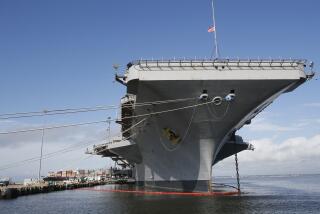‘Warship’ Is Well-Armed Tale
- Share via
SAN DIEGO — Midway through tonight’s opening installment of the documentary “Warship,” narrator Stacy Keach explains the risks that nations of yore confronted in their furious rush to build the biggest, meanest, most indestructible naval ship on the seas.
Anyone who thought that the idea of an arms race with cost overruns and shakey prototypes was a Cold War phenomenon should think again.
“Building a warship was the single most expensive project a government could undertake,” Keach says, “and yet much was left to chance in all new designs. Not until a ship was launched and tested could a design be deemed a success or failure.”
“Warship” is a richly detailed, briskly paced look at the dreamers, schemers and entrepreneurs who took those chances in a race to build ships and weaponry that could provide their country--or their client--with the ultimate prize: military supremacy on the seas.
Produced by Granada Television for Thirteen/WNET of New York, “Warship” traces the evolution of the military ship from the pre-Revolutionary War days of canvas and wood to the modern age of nuclear-powered submarines and aircraft carriers.
Most of the technological advances in sea power were the result of fierce competition between nations--at first, England, France and Spain, and later, the Americans, Germans and Japanese--for dominance. As a result, ships and shipbuilding is inextricably tied to feelings of national pride. One of the sly successes of “Warship” is its ability to summon up that sense of global rivalry.
Even now the British find the fact that American inventor Robert Fulton returned to America at the outbreak of war with the colonies a bit unseemly.
“When the War of 1812 broke out, Fulton immediately turned himself into an American patriot,” sniffs British naval historian Andrew Lambert. “Having been an English one and French one earlier on, he found it very easy to become an American one.”
On the other hand, U.S. naval expert Joe Leary can barely contain his glee in explaining how dumbfounded the British must have been in 1776 when one of their ships was attacked in New York harbor by a barrel-shaped, hand-powered vessel called the Turtle, the first U.S. submarine:
“I have this image that they’re standing there on their decks almost like the dinosaurs lookng down in condescension at the little mammals that are taking away their eggs.”
And British military historian Sir John Keegan explains that the British were not at all surprised that the German Navy already had a strategy for retreating when it confronted the British Navy early in World War I.
“It’s understandable the Germans, with the weaker fleet, should have a special technique for turning away. We [the British] don’t need it: We shall always be going toward the enemy.”
On the apparent theory that there is a limit to the public’s hunger for discussions of screw propellers and the conundrum of cavitation, “Warship” does a superb job of intersplicing discussions of technological advances with mini-profiles of the men who are now seen as visionaries but, during their lives, were often dismissed as cranks and scoundrels.
Men such as Swedish engineer John Ericsson who spent time in the London Debtors Prison before emigrating to America where he designed the sloop Princeton, the first world’s first warship to have its engines safely below the waterline.
Men such as Charles Parsons, inventor of the steam turbine, who built a small craft that upstaged the stately cruisers and battleships by roaring by at the astounding speed of 40 mph during a celebration in 1897 to celebrate Queen Victoria’s Diamond Jubilee.
Men such as Glenn Curtiss, the motorcyclist and pilot from upstate New York who convinced the Navy in 1910 that a plane could launch from the deck of a ship, thereby giving rise to the modern aircraft carrier.
Ships and planes are made of metal, but navies are made of men (and increasingly, in the U.S., of women), and some of the best moments in “Warship” capture the personalities of those who saw the future and grasped it.
One is British Adm. Sir John “Jacky” Fisher who championed the rise of the battleship before World War I and tried to break the stifling influence of the British class system in the Royal Navy.
The desperate struggle of the Royal Navy to break the stranglehold of the German U-boats during World War II is vividly portrayed. Much of the credit for the British success given to Adm. Max Horton, a veteran submariner.
“He was the classic poacher turned gamekeeper,” Lambert says. “ ... He insisted that the [German] submariners would be beaten not by avoiding them but by killing them.”
Technologies change, but as “Warship” notes, the objective of warfare from the sea remains the same--from the exchange of cannonballs at 500 yards at the Battle of Trafalgar in 1805, to a campaign of launching missiles and laser-guided bombs at certain caves in Afghanistan in 2001.
“In a world that is very unsettled,” says historian Norman Friedman, “the ability to project power can make a difference.”
*
The first part of “Warship” airs tonight on KCET at 9. The second part airs Nov. 14 at 9 p.m.
More to Read
The complete guide to home viewing
Get Screen Gab for everything about the TV shows and streaming movies everyone’s talking about.
You may occasionally receive promotional content from the Los Angeles Times.






